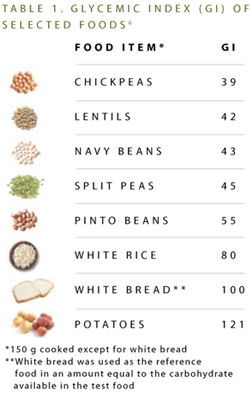If there’s one thing we know about losing weight, it’s that simply cutting calories isn’t always the answer. Those who have tried the Baby Food Diet and the Beyonce Diet can attest to this fact. This is because when we over-restrict calories, especially for extended periods of time, the pounds end up coming back and usually sticking around for good. 
However, one researcher, David Ludwig of the New Balance Foundation Obesity Prevention Center at Boston Children’s Hospital, argues that there’s one way to lose weight more efficiently and keep it off: a low glycemic diet.
DietsInReview.com’s registered dietitian Mary Hartley, RD, explains that a low glycemic index diet is touted as beneficial because it helps avert hunger and blood sugar dips by discouraging the rapid release release of insulin.
“The Glycemic Index (GI) ranks carbohydrate-containing foods based on how they affect blood glucose,” she said. “Foods with a low GI produce a gradual rise, while high GI foods bring about a sharp increase.”
Highly processed foods like potato chips and Twinkies are considered high GI foods. But there are also naturally-occurring foods like potatoes and corn that are considered high GI because they cause a spike in blood sugar as well.
In addition to causing blood sugar spikes, Ludwig also proposes that high GI foods release hormones that not only stimulate hunger but also slow metabolism, which is why it can be more difficult to keep the weight off in the long run.
As reported by NPR, Ludwig’s findings were published recently in the Journal of the American Medical Association. To carry out the study, he and several other researches conducted a side-by-side comparison of a low-carb, low-fat and low-glycemic diet on the basis of which burned the most calories per day.
 Findings showed that while the low-carb diet burned the most calories, the low-glycemic diet proved the winner because it burned more calories than the low-fat diet and was shown to be easier to stick to over time than the low-carb diet.
Findings showed that while the low-carb diet burned the most calories, the low-glycemic diet proved the winner because it burned more calories than the low-fat diet and was shown to be easier to stick to over time than the low-carb diet.
While the study was considered inconconsluvie, the preliminary findings were encouraging enough to urge Ludwig to begin designing a long-term study to confirm his hypothesis.
The findings may be in favor of a low glycemic diet, but Mary points out that the problem with the glycemic index is that it’s affected by other factors such as the kind and amount of protein, fat and fiber present in a total meal, as well as the content and timing of the previous meal and how the food is prepared.
Her solution? Think of your diet in terms of refined and unrefined plant-based foods. “I try to lay low on the refined carbohydrates – basically sugars and white flours – that have a high GI, in favor of unrefined carbohydrates, such as whole grains, legumes, and starchy vegetables that are high-fiber with a low GI,” said Mary. “I don’t care that potato and corn are high GI foods because I eat them within the context of a mixed dish.”
Mary’s diet advice for the average person? Pay attention to “food” over “nutrition” with a daily goal of eating a balanced diet of minimally processed foods in the correct amounts to stay satisfied for several hours. Additionally, she suggests we aim to maintain a healthy body weight and make high GI foods, such as sweets and other baked goods, an occasional indulgence.
Also Read:
Mediterranean Diet More Likely to Keep Off Weight Than Other Diets
